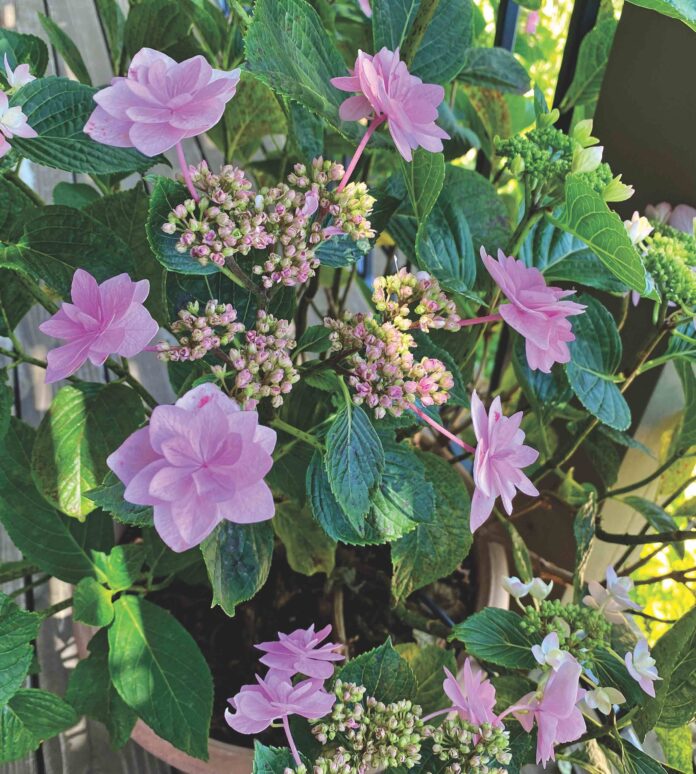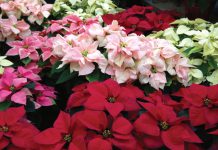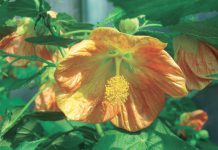
Recently I spent some time in a friend’s garden in Bonny Doon. This spectacular garden was included on Valley Church’s Garden Tour several years ago when several Bonny Doon gardens were featured. As in many gardens, there are some sunny spots and lots of shade under porch overhangs and trees. My friend Kate has figured out how she can have as much color in the shady areas of her garden as she has in the sunny spots.
Blooming wildly on Kate’s shady porch are several shooting star hydrangeas. Very hardy and reblooming, hydrangea Serrata reaches only 24 inches high and wide, perfect for small spaces and pots. It blooms on new wood and old wood, repeating all summer. This small shrub would be the “thriller” in a pot. I took away several cuttings of this and traditional mophead hydrangeas, so I started my collection again.
Every spring, before the fire, I would look forward to the unique flowers of my Queen’s Tears billbergia. Recently a fellow gardener gifted me a variegated one so I could carry on the tradition. This pineapple relative makes a vigorous, deer-resistant groundcover under trees without becoming invasive. Exotic-looking rosy-red spikes are topped with drooping pink, blue and green flowers that look like dangling earrings. Insects never bother them. Give them a little water now and then, and forget them. They’re that easy to grow.
The sound of rustling leaves is soothing to our ears. But many of the ornamental grasses that sway in the breeze don’t survive in shady locations. One that does is Japanese Forest Grass. There are several varieties of Hakonechloa that can brighten a dark spot next to your favorite lounging chair. Aureola has classic bright gold and lime green striped leaves. Also called Sweet Grass, my cat might relish them more than me! I love how each graceful leaf tumbles toward the light reminding me of flowing water.
Looking for shade tolerant flowering shrubs to cut for bouquets? Fragrant Daphne odora is a wonderful small shrub. Sweet olive or Osmanthus fragrans is a large evergreen shrub or small tree with blooms that smell like apricots in winter. For summer fragrance, grow Carol Mackie or Summer Ice Daphne.
Flowering plants to grow in dry shade areas include Bergenia, mahonia, fragrant Sarcococca, clivia and Mariesii Viburnum. Oakleaf hydrangea foliage and flowers look great in bouquets, and the leaves turn red in fall, which is a bonus.
Chinese Ground Orchid (Bletilla striata) is another of my favorite plants for shade. A natural companion for ferns and wildflowers, this plant is tougher than it looks. Vivid, magenta blooms resembling miniature Cattleya orchids emerge on long stalks for about six weeks in the spring.
For dry shade, try growing Kaffir lily (Clivia miniata). I have a bright orange blooming Belgian Hybrid. I hope to have many Clivias in the future as they divide so easily and bloom in fairly dark shade. Beautiful, robust green strappy leaves are handsome year-round, but the dozens of flower clusters containing as many as 60 flowers each brighten up any area. Drought-tolerant, they make a gorgeous accent, border or container specimen once established.
Sure, every garden is different—different look, different soil, different degree of shade, but it’s surprising how often one of these plants plays a starring or supporting role in a vignette or border
I use all of these tough plants in designs for shady gardens because I know they will look beautiful, provide color, and, most importantly, thrive. These plants are for you if you have a garden that gets little winter light. Those who live under the trees know a shady garden is a pleasant place to spend time on a hot summer day. Be thankful for what you do have.












